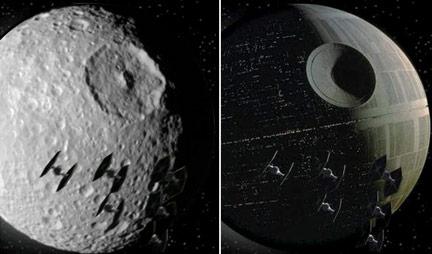 In 1977 George Lucas released Star Wars and in it was featured the now infamous Death Star space station which was justly destroyed in the films final scene. That same year Voyager 1 was launched from Earth on its way to the outer solar system. On its way through the Saturnian system it relayed back images of a moon that bore a striking resemblance to Lucas’s own vision of the Death Star.
In 1977 George Lucas released Star Wars and in it was featured the now infamous Death Star space station which was justly destroyed in the films final scene. That same year Voyager 1 was launched from Earth on its way to the outer solar system. On its way through the Saturnian system it relayed back images of a moon that bore a striking resemblance to Lucas’s own vision of the Death Star.
The only feature that really makes the resemblance complete is the presence of the Herschel crater which, like the Death Star, occupies almost 1/3 the moon’s own diameter. The central peak, which often occurs on larger sized impacts, also makes for a good stand in for the giant laser turret that destroys planets. With results of the Voyager mission streaming in a few years after the film became a smash hit and just a few months after the release of “Empire Strikes Back” one has to wonder if anyone at mission control uttered the words, “That’s no moon”.
However, while the circular feature on the Death Star destroys other worlds, Mimas’s giant circular feature nearly destroyed its own self. The crater is so large in comparison to the size of the moon itself it is believed that it was quite close to shattering the small moon into many bits which maybe could have resulted in even more rings for Saturn. As it is there are fractures on the opposite side of the moon which some suggest may be stress lines from that same impact and show evidence that the moon did start to become unhinged. Proportional to the size of the body itself, this is the largest crater in the Solar System with only Mars’s moon Phobos coming close with its Stickney crater.